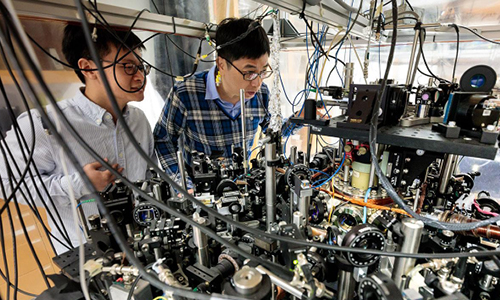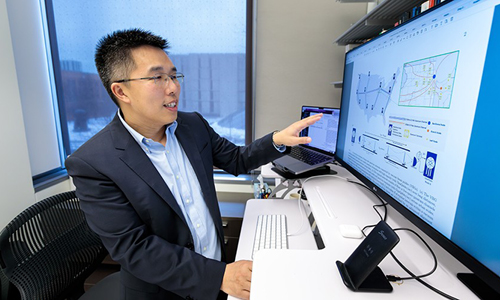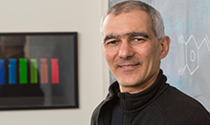|
|
|
|
|
|
| |
Quantum mechanics explores the tiniest particles in the universe, with an impact that extends beyond physics to chemistry, computer science, and medicine. As the home of the Chicago Quantum Exchange—a regional hub of quantum innovation—UChicago stands ready to lead this transformative field. |
|
| |
|
|
|
| |
When particles have chemistry |
|
| |
|
|
|
|
|
| |
| |
|
|
| |
Zhendong Zhang, SM’22, PhD’22, (left) and physics professor Cheng Chin are coauthors of a study revealing the first evidence of quantum superchemistry. Photography by John Zich. |
|
| |
|
|
|
|
| |
|
|
|
| |
Scientists from the University of Chicago found the first experimental evidence of “quantum superchemistry,” a phenomenon in which particles in the same quantum state undergo collective and accelerated chemical reactions. Cooling cesium atoms into a shared quantum state allows them to react collectively rather than through independent collisions, leading to faster reaction rates. The molecules resulting from these collisions also share the same quantum state, offering new control over reaction outcomes. The discovery represents a significant step toward understanding quantum-enhanced chemical reactions and could have implications for quantum chemistry, computing, and engineering, as well as fundamental physics research. |
|
| |
|
|
|
|
|
| |
Leaps and bounds in quantum mechanics |
|
| |
|
|
|
| |
|
|
|
| Ancient algorithm: Taking inspiration from an experiment in 240 BCE Alexandria, a new algorithm enables quantum computers to simulate molecular systems more accurately. |
|
|
|
| |
|
|
|
|
|
| |
|
|
|
| Entangled: UChicago chemists improved a technique to simulate complex quantum mechanical effects, leading to easier development of materials for technologies like solar cells and quantum computers. |
|
|
|
| |
|
|
|
|
|
| |
|
|
|
| Totally tubular: A UChicago study used quantum computer simulations to understand how microtubules assemble and function inside cells, a possible step toward more precise cancer treatments. |
|
|
|
| |
|
|
|
|
|
|
|
|
|
|
|
|
|
| |
| |
|
|
| |
Professor of molecular engineering Liang Jiang reviews the proposed quantum network that uses vacuum beam guides. Photography by John Zich. |
|
| |
|
|
|
|
| |
|
|
|
| |
A novel method for building large-scale quantum networks, proposed by UChicago researchers, could transform quantum computing and communication technologies. Classical computer networks and current approaches under study can’t effectively send quantum bits, or qubits, because of information loss and the inability to maintain the quantum properties. |
|
| |
|
|
|
| |
The new approach would use vacuum-sealed tubes equipped with spaced-out lenses to transport photons of light encoding quantum data across thousands of kilometers. With the potential to transmit 10 trillion qubits per second, the proposed network could revolutionize cybersecurity, data processing, and quantum computing and sensing technologies. |
|
| |
|
|
|
|
|
|
|
|
|
| |
| |
|
|
| |
A matter of discovery:
Meet the researchers focusing on the science of “stuff”—the new metal alloys, chemical compounds, and versatile plastics of emerging technology.
|
| |
|
|
|
|
|
|
| |
|
|
|
|
|
| |
| |
Sign up to receive µChicago monthly. |
|
|
|
| |
|
|
|
|





